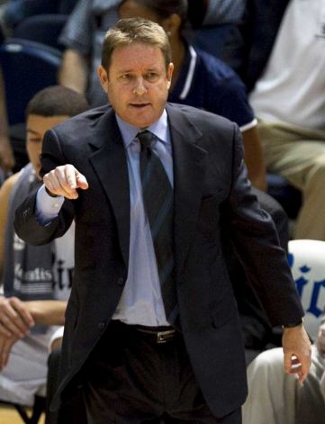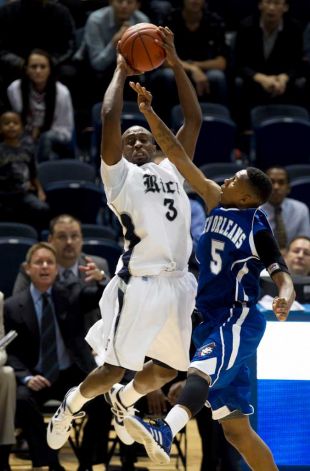Frank Erwin Center | Austin, TX | Tip: 1 P.M. CT | TV: Longhorn Network LRT Consecutive Game #199 After a nine-day layoff, the Texas Longhorns return to action this afternoon, closing out 2011 against their old Southwest Conference rivals, the Rice Owls. In recent years, the Owls have not proven to be much of a challenge for the Longhorns, dropping all five games against Texas since Rick Barnes has arrived on the 40 Acres.
Ben Braun has turned things around at Rice Ben Braun has the Owls headed in the right direction, though. Last season, the Longhorns won by just three points when they faced Rice at the Erwin Center, while last week the Owls snapped Texas A&M’s 67-game non-conference winning streak at Reed Arena. If the Longhorns were looking for an easy victory to wash the taste of the North Carolina debacle out of their mouths, this match-up certainly doesn’t fit that bill. By the numbers Rice is a big team by Conference USA standards, and as a result they make their living in the paint. Nearly 80% of their points come from the free throw line or inside the arc, while the team’s free-throw rate is 14th-highest in Division I. The Owls have an FTR of 48.3%, meaning that they average almost one free throw for every two field goal attempts. On the other side of the ball, that formidable size equates to solid defense inside and some questionable numbers at the perimeter. The Owls are allowing D-I opponents to make more than 38% of their threes this year, a number that puts them in the bottom 50 nationally. Of course, it should be noted that those stats are skewed slightly by an insane 14-of-29 performance by Iowa State when the teams met in South Padre last month. On the glass, the size of the Rice roster doesn’t add up to the numbers you might expect. Not surprisingly, their defensive rebounding percentage is 20th in the nation, as the Owls only allow opponents to reclaim 26.6% of their missed shots. On the offensive end, however, Rice is rather mediocre. Despite having Arsalan Kazemi, whose personal OR% of 15.3 is 37th in the country, the team is grabbing just 31.5% of their offensive board opportunities, slotting the Owls a disappointing 211th in the nation. Meet the Owls Everything begins and ends with Kazemi (No. 14) for Rice. The Iranian-born big man is averaging a double-double, logging 13.9 points and 12.5 rebounds per game. At 6’7″, he can play the post against most C-USA opponents, but is often undersized against major conference foes. Kazemi has a solid array of post moves, however, and is a highly skilled passer and serviceable ball handler. Even with all those skills, Kazemi makes his hay at the free throw line. His free-throw rate is 13th-highest in D-I hoops this year, and he finished his sophomore campaign with the second-best mark in the nation. Fortunately, Kazemi is only making about 63% of his free throws this year, so the main concern for the Longhorns is foul trouble. With a thin frontcourt, Texas will have to make sure they can defend Rice’s big man without drawing too many whistles.
Junior guard Tamir Jackson keeps the offense humming The other junior leader for Rice is Tamir Jackson (No. 3), a combo guard from New Jersey who has taken the role of point by default. Averaging 13.7 points and 3.6 assists per game, Jackson is a strong 6’3″ guard who can slash to the rim, draw fouls, and finish through the contact. Like Kazemi, Jackson also struggles at the line, where he has made just 63.5% of his attempts so far. Joining Jackson in the backcourt is sharpshooter Connor Frizzelle (No. 4), a senior who has struggled in his three previous meetings with Texas. Despite averaging 27.3 minutes in those games, Frizzelle has made just 1-of-9 from behind the arc and averaged just 3.7 points. This year, he’s third on the team with 8.8 points per game, and is the team’s most reliable shooter on the kickouts from Kazemi. Frizzelle also has a good pull-up jumper, and likes to use it after a strong head fake draws the close-out from opposing defenders. The team’s other spot-up shooter on the perimeter is Lucas Kuipers (No. 20), also a senior. At 6’8″, the forward from Minnesota is a threat both inside and outside, and is one of the team’s better rebounders outside of Kazemi. On offense, he typically hangs out around the perimeter, spacing the floor for the big man inside. On defense, though, he’s a big part of Rice’s success at limiting opponents to one-shot possessions. The fifth starting slot has been split between a pair of freshmen, Julian DeBose (No. 15) and Dylan Ennis (No. 31). DeBose is an athletic wingman out of Washington, D.C., but is working his way back from an ankle injury that kept him out of the A&M game. On Wednesday night, he played just seven minutes against Texas A&M-Corpus Christi. Ennis is a 6’2″ Canadian guard who finished his high school career at Lake Forest Academy in Chicago. He’s a natural leader who will likely take over full-time point guard duties in the future, but is still averaging more than 22 minutes as a freshman. He is really struggling from long range, where he’s made just 19% of his attempts this season, so the Longhorns can sag off to limit his ability to drive the lane. Off the bench, freshman wing Ahmad Ibrahim (No. 0) has had an impressive start to his college career. Originally from Lebanon, Ibrahim has an ability to find the cracks in the defense for flashy drives to the hoop. He has solid handles and great body control, so even when his shot looks impossible to finish, he typically finds a way to sink it. The international theme continues for the Owls when you look at frontcourt reserve Omar Oraby (No. 34), who hails from Cairo, Egypt. Although he’s playing just a little over seven minutes per game, he has made huge steps forward in his sophomore campaign. At 7’2″, Oraby is still a raw talent, but he has really soft hands to corral rebounds and moves well laterally to help out on defense. And of course, when a 7’2″ guy is standing tall on the block, it seriously limits the interior options for opponents. In addition to a player from Lebanon, Egypt, Iran, and Canada, the Owls also have German product Jarelle Reischel (No. 12), a freshman wing who finished his high school career in New Jersey. Reischel is averaging less than 12 minutes per game this season, limited mostly by his struggles to hang on to the ball. His individual turnover rate of 34.7% is by far the worst on the team. The only other player averaging more than 10 minutes per game is 6’7″ freshman Seth Gearhart (No. 41). The Oregon native still needs to add some muscle to be effective in college, but has already shown good ball handling skills and the ability to slash from the wings. He’s also keeping defenders honest with his three-point threat, as he’s knocked down 46% of his long-range looks in his limited minutes. Keys to the game 1) Earn second-chance points — The Longhorns have become one of the best offensive rebounding teams in the country over the last few weeks, but they will be facing a tough test against a Rice team that is one of the best on the defensive glass. The Owls limited A&M to less than 30% of their offensive board opportunities in their upset victory at Reed Arena last week, so the Longhorns will have to do a better job if they want to avoid the same fate as the Aggies. 2) Knock down perimeter looks — Rice will give up their fair share of easy looks from beyond the arc, so the Longhorns will have to take advantage of that opportunity. The Owls were repeatedly confounded by a simple dribble handoff when they lost to Iowa State in South Padre, so Texas should be able to get J’Covan Brown, Julien Lewis, Sterling Gibbs, and Sheldon McClellan some open looks from long range. 3) Take care of the basketball — The Owls don’t force a ton of turnovers, but the same could have been said about North Carolina prior to their thorough whipping of the Longhorns last Wednesday. Texas allowed 21 Tar Heel points off of their 13 turnovers, many of them coming as a result of forcing plays that weren’t there. The Longhorns — particularly Myck Kabongo — need to use a smarter, more patient approach against Rice this afternoon, or else they will be giving away free points to a Rice team that is great in transition. |










